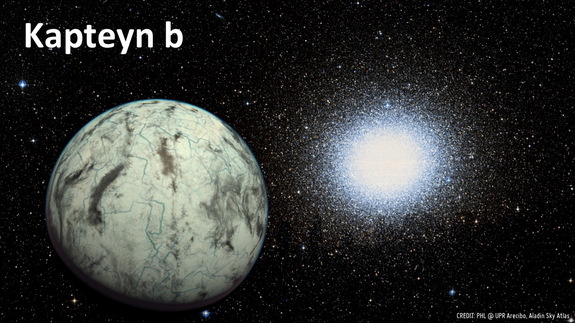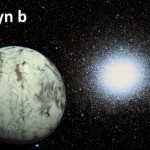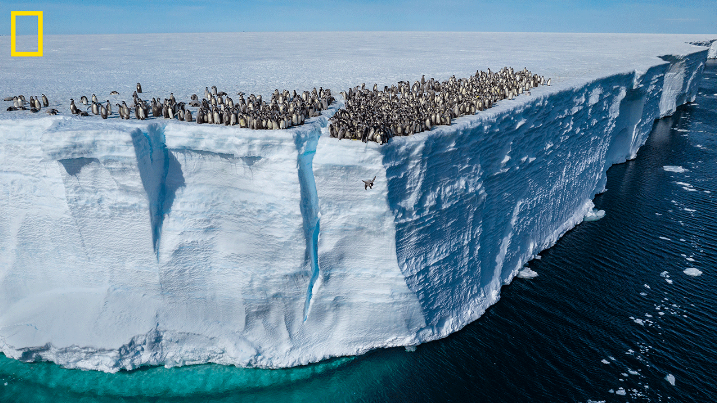
Artistic representation of the potentially habitable world Kapteyn b with the globular cluster Omega Centauri in the background. It is believed that the Omega Centauri is the remaining core of a dwarf galaxy that merged with our own galaxy billions of years ago bringing Kapteyn’s star along. Image released June 3, 2014.
Credit: PHL @ UPR Arecibo, Aladin Sky Atlas
View full size image
Astronomers have discovered what appears to be the oldest known alien world that could be capable of supporting life, and it’s just a stone’s throw away from Earth.
The newfound exoplanet candidate Kapteyn b, which lies a mere 13 light-years away, is about 11.5 billion years old, scientists say. That makes it 2.5 times older than Earth, and just 2 billion years or so younger than the universe itself, which burst into existence with the Big Bang 13.8 billion years ago.
“It does make you wonder what kind of life could have evolved on those planets over such a long time,” study lead author Guillem Anglada-Escude, of Queen Mary University of London, said in a statement. [10 Exoplanets That Could Host Alien Life]
Anglada-Escude was referring to Kapteyn b and its newly discovered sister world, Kapteyn c, which both orbit a nearby red dwarf known as Kapteyn’s Star. But only Kapteyn b, a “super-Earth” about five times as massive as our own planet, is thought to be potentially habitable; the larger Kapteyn c is likely too cold, researchers said.
The astronomers spotted both alien planets by noting the tiny wobbles their gravitational tugs induced in the motion of Kapteyn’s Star. These tugs caused shifts in the star’s light, which were first detected using the HARPS spectrometer at the European Southern Observatory’s La Silla Observatory in Chile. Further observations by two other spectrometers — HIRES at the Keck Observatory in Hawaii and the PFS instrument at Chile’s Magellan II Telescope — backed up the finds.
The team didn’t expect to find a possibly habitable world around Kapteyn’s Star, which is one-third as massive as the sun but so close to Earth that it’s visible in amateur telescopes, in the southern constellation of Pictor.
“We were surprised to find planets orbiting Kapteyn’s Star,” Anglada-Escude said. “Previous data showed some moderate excess of variability, so we were looking for very short-period planets when the new signals showed up loud and clear.”
Kapteyn b lies in the star’s habitable zone, the range of distances that could support liquid water — and thus, perhaps, life as we know it — on a world’s surface. The exoplanet completes one orbit every 48 days. The colder Kapteyn c is much farther out, circling the star once every 121 days.
Adding to the intrigue is the strange history of the Kapteyn system. The star originally belonged to a dwarf galaxy that our own Milky Way eventually absorbed and disrupted, researchers said, throwing Kapteyn and its planets into their speedy, elliptical orbit in the galactic “halo” — the region surrouding the Milky Way’s familiar spiral-armed disk.
The remnant of this gobbled-up dwarf galaxy is likely Omega Centauri, a globular cluster about 16,000 light-years away that contains many thousands of stars that are around 11.5 billion years old, researchers said.
“The presence and long-term survival of a planetary system seems a remarkable feat given the peculiar origin and kinematic history of Kapteyn’s star,” the researchers write in the new study, which will be published in the Monthly Notices of the Royal Astronomical Society. “The detection of super-Earth mass planets around halo stars provides important insights into planet-formation processes in the early days of the Milky Way.”
The new discovery is an exciting one that could inform the search for alien life throughout the galaxy, outside researchers said.
“It suggests that many potentially habitable worlds will be found in the next years around nearby stars by ground-based and space-based observatories such as ESA’s PLATO mission,” said Richard Nelson of Queen Mary University of London, who was not a part of the study team. “Until we have detected a larger number of them, the properties and possible habitability of the near-most planetary systems will remain mysterious.”








 Photographer Finds Locations Of 1960s Postcards To See How They Look Today, And The Difference Is Unbelievable
Photographer Finds Locations Of 1960s Postcards To See How They Look Today, And The Difference Is Unbelievable  Hij zet 3 IKEA kastjes tegen elkaar aan en maakt dit voor zijn vrouw…Wat een gaaf resultaat!!
Hij zet 3 IKEA kastjes tegen elkaar aan en maakt dit voor zijn vrouw…Wat een gaaf resultaat!!  Scientists Discover 512-Year-Old Shark, Which Would Be The Oldest Living Vertebrate On The Planet
Scientists Discover 512-Year-Old Shark, Which Would Be The Oldest Living Vertebrate On The Planet  Hus til salg er kun 22 kvadratmeter – men vent til du ser det indvendigt
Hus til salg er kun 22 kvadratmeter – men vent til du ser det indvendigt  Nearly Frozen Waves Captured On Camera By Nantucket Photographer
Nearly Frozen Waves Captured On Camera By Nantucket Photographer  It’s Official: Astronomers Have Discovered another Earth
It’s Official: Astronomers Have Discovered another Earth  Meteorite That Recently Fell in Somalia Turns Out to Contain Two Minerals Never Before Seen on Earth
Meteorite That Recently Fell in Somalia Turns Out to Contain Two Minerals Never Before Seen on Earth  Superknepet – så blir snuskiga ugnsformen som ny igen!
Superknepet – så blir snuskiga ugnsformen som ny igen! 